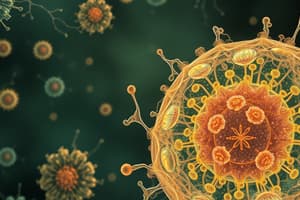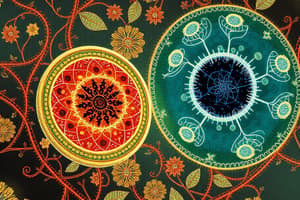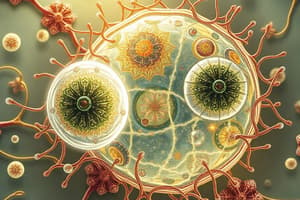Podcast
Questions and Answers
Which of the following components is NOT found in eukaryotic cells?
Which of the following components is NOT found in eukaryotic cells?
- Cell wall (correct)
- Cell membrane
- True nucleus
- Mitochondria
What type of molecules determine blood type and serve as receptors for cells?
What type of molecules determine blood type and serve as receptors for cells?
- Phospholipids
- Glycoproteins (correct)
- Lipids
- Proteins
What is the primary function of the cell membrane?
What is the primary function of the cell membrane?
- Energy production
- Regulation of nutrient and waste passage (correct)
- Facilitation of cellular division
- Genetic material storage
What is the process called when water moves through a semipermeable membrane?
What is the process called when water moves through a semipermeable membrane?
Which statement correctly describes prokaryotic cells?
Which statement correctly describes prokaryotic cells?
What characterizes an isotonic solution?
What characterizes an isotonic solution?
Which part of the phospholipid is hydrophilic?
Which part of the phospholipid is hydrophilic?
Facilitated diffusion involves what type of proteins?
Facilitated diffusion involves what type of proteins?
What is the primary effect of a hypertonic solution on a cell?
What is the primary effect of a hypertonic solution on a cell?
Which component of the nucleus is responsible for the assembly of ribosomes?
Which component of the nucleus is responsible for the assembly of ribosomes?
What function does the Rough Endoplasmic Reticulum primarily serve?
What function does the Rough Endoplasmic Reticulum primarily serve?
Which of the following statements about cytoplasm is true?
Which of the following statements about cytoplasm is true?
What happens to chromatin when a cell begins to divide?
What happens to chromatin when a cell begins to divide?
Which organelle acts as the traffic director for cellular proteins?
Which organelle acts as the traffic director for cellular proteins?
What is the function of lysosomes in a cell?
What is the function of lysosomes in a cell?
What happens to lysosomes under conditions of high Vitamin A and low oxygen?
What happens to lysosomes under conditions of high Vitamin A and low oxygen?
What is the primary function of peroxisomes in kidney and liver cells?
What is the primary function of peroxisomes in kidney and liver cells?
Which structure is responsible for directing the formation of the mitotic spindle?
Which structure is responsible for directing the formation of the mitotic spindle?
What do peroxisomes convert free radicals into?
What do peroxisomes convert free radicals into?
What are microtubules primarily involved in?
What are microtubules primarily involved in?
Which type of filament is primarily associated with cell motility?
Which type of filament is primarily associated with cell motility?
What does the inner membrane of mitochondria form that is critical to its function?
What does the inner membrane of mitochondria form that is critical to its function?
What is a significant characteristic of mitochondria?
What is a significant characteristic of mitochondria?
What cellular structures are formed by the multiplication of centrioles?
What cellular structures are formed by the multiplication of centrioles?
What is the primary purpose of cell division?
What is the primary purpose of cell division?
During which stage of cell division do daughter chromosomes move toward the poles?
During which stage of cell division do daughter chromosomes move toward the poles?
What role does transfer RNA (tRNA) play in protein synthesis?
What role does transfer RNA (tRNA) play in protein synthesis?
Which stage of cell division marks the beginning of cytokinesis?
Which stage of cell division marks the beginning of cytokinesis?
What is the function of messenger RNA (mRNA) in cells?
What is the function of messenger RNA (mRNA) in cells?
What occurs during transcription in protein synthesis?
What occurs during transcription in protein synthesis?
Which of the following is NOT a stage of mitosis?
Which of the following is NOT a stage of mitosis?
What is the significance of the mitotic spindle during cell division?
What is the significance of the mitotic spindle during cell division?
Flashcards are hidden until you start studying
Study Notes
Cells: The Fundamental Units of Life
- Cell Theory: Explains the basic principles of cells:
- All living things are composed of cells.
- Cells are the smallest units of structure and function in living organisms.
- New cells arise from pre-existing cells.
- Types of Cells:
- Prokaryotic: Lack a true nucleus; energy production occurs within cell membranes.
- Eukaryotic: Possess a true nucleus; energy production occurs within mitochondria.
- Major Parts of a Eukaryotic Cell:
- Cell Membrane (Plasma Membrane): A selectively permeable barrier composed of a phospholipid bilayer embedded with proteins:
- Functions: Regulates the passage of nutrients, waste products, and secretions into and out of the cell.
- Selective Permeability: Allows certain substances to pass through while restricting others.
- Composition:
- Phospholipids:
- Head: Hydrophilic (water-loving), faces the watery environment.
- Tail: Hydrophobic (water-hating), faces away from the water.
- Proteins: Float within the lipid portion, serving diverse functions:
- Enzymes: Catalyze biochemical reactions.
- Carriers: Transport specific molecules across the membrane.
- Receptors: Bind to hormones and chemical messengers, initiating cellular responses.
- Glycoproteins: Determine blood type, act as receptors for bacteria, viruses, and toxins, and facilitate cell-to-cell interactions.
- Phospholipids:
- Transport Mechanisms: Various mechanisms move substances across the membrane:
- Passive Diffusion: Movement of molecules from a high concentration to a low concentration across the membrane without energy input.
- Facilitated Diffusion: Similar to passive diffusion but requires a protein carrier to assist movement.
- Active Transport: Movement of molecules against their concentration gradient, requiring energy expenditure.
- Endocytosis/Exocytosis: Bulk transport of materials into (endocytosis) or out of (exocytosis) the cell.
- Nucleus: The cell's control center; contains the genetic material (DNA):
- Nuclear Membrane (Envelope): Double membrane surrounding the nucleus, containing pores for the passage of large molecules.
- Nucleoplasm: A gel-like matrix within the nucleus, similar to cytoplasm.
- Nucleolus: A dense region within the nucleus where ribosomes are assembled.
- Chromatin/Chromosomes:
- Chromatin: Uncoiled DNA, associated with proteins, within the nucleus when the cell is not dividing.
- Chromosomes: Condensed, threadlike structures of DNA that become visible during cell division.
- Cytoplasm: The semi-fluid, gelatinous region between the cell membrane and nucleus; site of most cellular metabolic reactions:
- Cytosol: The semitransparent fluid component of the cytoplasm, containing water, nutrients, and dissolved substances.
- Inclusions: Non-functional units within the cytoplasm; storage sites for nutrients or cell products: - Fat droplets - Glycogen granules - Pigments (e.g., melanin) - Mucus - Crystals
- Organelles: Specialized structures within the cytoplasm that carry out specific metabolic functions: - Ribosomes: Sites of protein synthesis, either free in the cytoplasm or attached to membranes. - Endoplasmic Reticulum (ER): A network of interconnected membranes that serves as a mini-circulatory system within the cell: - Rough ER: Contains ribosomes; abundant in cells that export protein products, such as pancreatic cells. - Smooth ER: Lacks ribosomes; involved in cholesterol synthesis, fat metabolism, detoxification of drugs, and steroid hormone production. - Golgi Apparatus (Complex): Modifies, sorts, and packages proteins synthesized by the ER: - Functions as a "traffic director" for cellular proteins. - Proteins accumulate in the Golgi apparatus, travel to the plasma membrane, and are released as secretory vesicles (exocytosis). - Lysosomes: "Demolition sites" of the cell, containing digestive enzymes: - Abundant in white blood cells (WBCs). - Breakdown worn-out organelles, cellular debris, and foreign substances. - Peroxisomes: Membranous sacs containing powerful oxidase enzymes that use oxygen to detoxify poisonous substances: - Found in kidney and liver cells. - Disarm dangerous free radicals by converting them to hydrogen peroxide which is then broken down to water. - Mitochondria: "Powerhouses" of the cell, responsible for energy production: - Double-walled structures with an outer membrane and an inner membrane folded into cristae. - Enzymes within the mitochondria break down food molecules using oxygen, releasing energy that is stored in ATP (adenosine triphosphate) molecules. - Cytoskeleton: A network of protein filaments that provides structural support, aids in intracellular transport, and facilitates cellular movement: - Composed of: - Microtubules: Involved in cell division, overall cell shape, and distribution of organelles. - Intermediate Filaments: Contribute to cell structure and provide attachment sites for desmosomes (cell junctions). - Microfilaments (Actin and Myosin): Essential for cell motility, changes in cell shape, and muscle contraction. - Centrioles: Small, cylindrical structures that play a role in cell division: - Direct the formation of the mitotic spindle (a structure that separates chromosomes during division). - Involved in the formation of cilia and flagella. - Cilia: Short, hair-like projections that beat rhythmically to create movement (e.g., in lung cells). - Flagella: Longer, whip-like projections that enable cell movement (e.g., sperm cells).
- Cell Membrane (Plasma Membrane): A selectively permeable barrier composed of a phospholipid bilayer embedded with proteins:
Cell Life Cycle:
- The cell cycle consists of two main periods:
- Interphase: The period when the cell grows and carries out its ordinary metabolic activities.
- Cell Division: The process of a cell replicating itself to produce two daughter cells:
- Function: For growth, replacement, and repair of the cell.
- Mitosis: Division of the nucleus, resulting in two identical daughter nuclei.
- Cytokinesis: Division of the cytoplasm, beginning near the end of mitosis, resulting in two daughter cells.
Stages of Cell Division:
- Interphase: A period of growth, metabolic activity, and preparation for cell division, but no actual cell division occurs.
- Prophase: The first stage of mitosis, where the chromosomes condense and become visible, and the spindle fibers start forming.
- Metaphase: Spindle fibers are attached to chromosomes that align at the center of the cell.
- Anaphase: The centromeres of the chromosomes separate, and sister chromatids are pulled toward opposite poles of the cell.
- Telophase: The final stage of mitosis, where the chromosomes reach opposite poles of the cell and begin to uncoil, the nuclear envelope reforms around each set of chromosomes, and cytokinesis begins.
Protein Synthesis:
- Gene: A segment of DNA that carries the instructions for building a specific protein.
- Proteins: Essential for various cellular functions:
- Building materials for cells
- Act as enzymes (biological catalysts)
- RNA (Ribonucleic Acid): Essential for protein synthesis:
- Transfer RNA (tRNA): Transfers amino acids to the ribosome for protein construction.
- Ribosomal RNA (rRNA): Combines with proteins to form ribosomes, the sites of protein synthesis.
- Messenger RNA (mRNA): Carries the genetic code from DNA in the nucleus to the ribosome in the cytoplasm.
Transcription and Translation:
- Transcription: The process of transferring information from the base sequence of DNA to the complimentary base sequence of mRNA.
- Translation: The process of converting the base sequence of mRNA into an amino acid sequence.
- Amino acids are the building blocks of proteins.
Studying That Suits You
Use AI to generate personalized quizzes and flashcards to suit your learning preferences.




